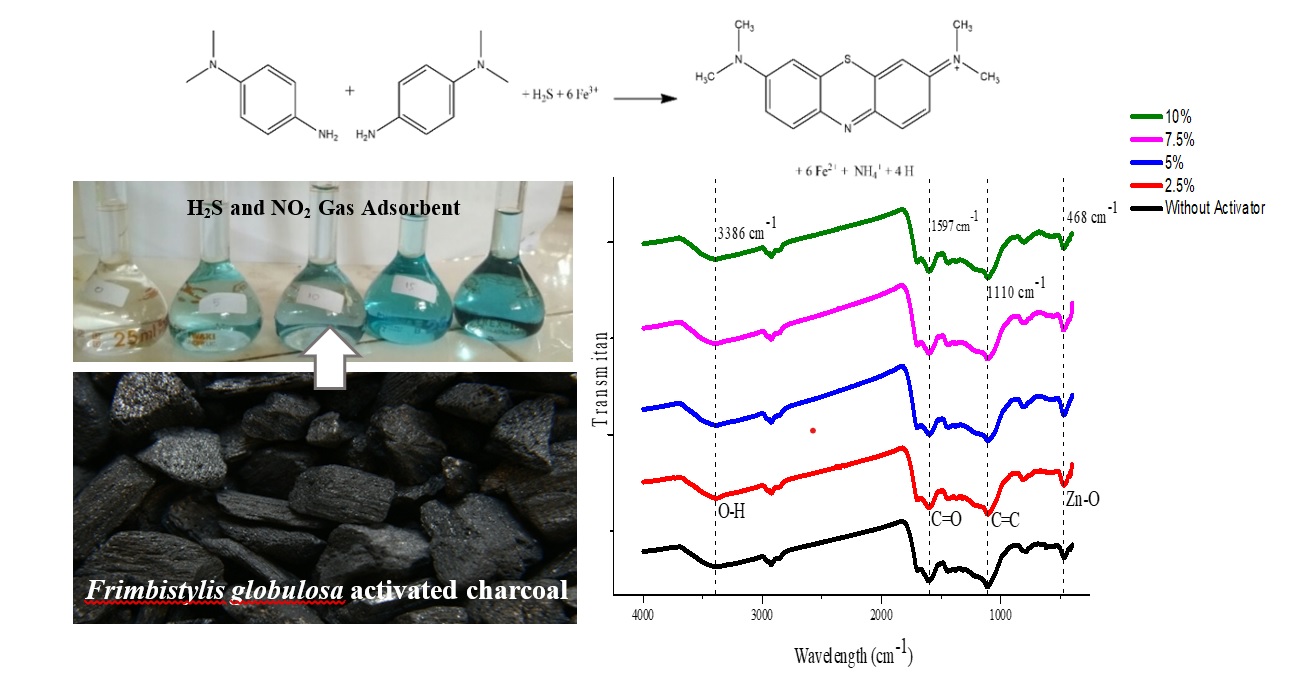Utilization of Mendong Plants-Activated Charcoal as H2S and NO2 Gas Adsorbent: Preliminary Study
Abstract

References
[1] Government Regulation No. 41 of 1999, on Air Pollution Control, Sheet RI of 1999 No. 88, 1999, Secretary of State: Jakarta.
[2] WHO, Summary of Risk Assessment: WHO Air Quality for Particulate Matter, Ozone, Nitrogen Dioxide and Sulfur Dioxide, Global Update 2005, 2005,16-17.
[3] WHO, WHO Guidelines for Indoor Air Quality: Selected Pollutants, 2010, 202-204.
[4] BPS DKI Jakarta, Prov. DKI Jakarta Dalam Angka, 2018, Jakarta.
[5] World Air Quality Index (AQI) Ranking | Air Visual (online) (https://www.airvisual.com/world-air-quality-ranking accessed on September 5, 2019 at 14.00 WIB).
[6] KLHK. ISPU, Direktorat Jendral Pencemaran Udara (online) (http://iku.menlhk.go.id/index/index/prop/36/id/ID-BT, accessed on August 2st 2019, at 12.09 WIB).
[7] KLH, Ministerial Decree of State Environmental No. Kep-50/menlh/11/1996 on Odor Level Quality Standards, 1996, Jakarta
[8] Soemirat, J., Kesehatan Lingkungan, 2009, Gajah Mada University Press, Yogyakarta.
[9] Ivana, S. C., Rachmaniyah and Nurmayanti, D., Gema Kesehat. Lingkung, 2017, 50(1): 52-58.
[10] Huboyo, H.S., Istirokhatun, T., and Sutrisno, E, J. Presipitasi: Media Komunikasi dan Pengembangan Teknik Lingkungan, 2016, 13(1), 8-12.
[11] Yusuf, I.H., Abd. W.W., and Maming, Adsrobsi Emisi Gas CO, NO, NOX Menggunakan Arang Aktif dari Limbah Ampas Tebu (Saccharum officinarum) pada Kendaraan Bermotor Roda Empat, Universitas Hasanuddin, 2015.
[12] Fardiaz, S., Polusi Udara dan Air, 1992, Kansius, Bogor.
[13] Elvitriana., Vera, V., and Sari, W, Prosiding Seminar Nasional Pascasarjana, 2017, Unsyiah.
[14] Belhachemi, M., Jeguirim, M., Limousy, L., and Addoun, F, Chem. Eng. J., 2014, 253, 121-129.
[15] Hui, Y.A.N.G., Hao, L.I.U., Kang, Z.H.O.U., Yan, Z.Q., Ran, Z.H.A.O., LIU, Z.H., and QIU, J.R., J. Fuel Chem. Technol, 2012, 40(8), 1002-1008.
[16] Simbolon, V.A., Nurmaini, N., and Hasan, W., JKLI, 2019, 18(1), 42-49.
[17] Jeguirim, M., Belhachemi, M., Limousy, L., and Bennici, S., Chem. Eng. J, 2018, 347, 493-504.
[18] Florent, M., Tocci, M., and Bandosz, T.J., Carbon, 2013, 63, 283-293.
[19] Yoo, J.Y., Park, C.J., Kim, K.Y., Son, Y.S., Kang, C.M., Wolfson, J.M., Jung, I.H., Lee, S.J., and Koutrakis, P., J. Hazard. Mater, 2015, 289, 184-189.
[20] Suryanto, H., Marsyahyo, E., Irawan, Y.S., and Soenoko, R., Key Eng. Mater, 2014, 594, 720–724.
[21] Suryanto, H., Marsyahyo, E., Irawan, Y. S., and Soenoko, R, J. Nat. Fibers, 2014, 11(4), 333–351.
[22] Suryanto, H., Solichin, S., and Yanuhar, U., Fiber Plants, 2016, 35-52.
[23] SNI 19-7117.7-2005, Emisi Gas Buang Sumber Tidak Bergerak-Bagian 7: Cara Uji Kadar Hidrogen Sulfida (H2S) dengan Metode Biru Metilen dengan Menggunakan Spektrofotometer, 2005, Badan Standardisasi Nasional, Jakarta.
[24] BSN, Cara Uji Kadar Nitrogen Dioksida (NO2) dengan Metode Griess Saltzman Mengunakan Spektrofotometer, SNI 19-7119.2-2005, 2005, Jakarta.
[25] EPA 2020, https://www.epa.gov/air-emissions-monitoring-knowledge-base/monitoring-control-technique-activated-carbon-adsorber, Accesed 17 January 2021.
[26] BAT-knowledge center 2020 (Belgium: VITO), LUSS -activated carbon adsorption, https://emis.vito.be/en/bat/tools-overview/sheets/activated-carbon-adsorption, Accesed 17 January 17, 2021.
[27] Ashadi, A., Khoirunnisa’Arabbani, F., Indriyanti, N.Y., Saputro, S., and Mahardiani, L., IOP Conf. Ser. Mater. Sci. Eng., 2020, 982(1), 012040.
[28] Zulaechah, L.S., Chanief, A.Z.I., and Wahyudi, D.T., Unnes Physics Journal, 2017, 69(1), 31-36.
Tsikas, D., J. Chromatogr. B, 2007, 851(1–2), 51– 70.
Refbacks
- There are currently no refbacks.

This work is licensed under a Creative Commons Attribution-NonCommercial 4.0 International License.








